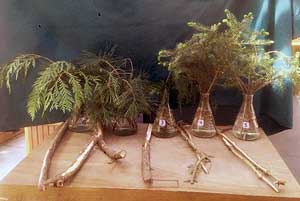The Boys and Girls and Their Boats

Opening Day crew races through the Montlake Cut, and the 1936 USA Olympic gold in rowing may never have happened without these following trees:
1) Thuja plicata Western Red Cedar
- UW’s world-renowned boat maker, George Pocock followed the lead of Native Americans and used this Pacific Northwest giant for the hulls of his Pocock Classics.
- The skin is made from a single plank of 3/32″ thick cedar and offers a combination of stiffness and springiness that eliminates the need for the extra weight of a hull.
2) Pinus lambertiana Sugar Pine
- Keels of Pocock’s boats were made from this soft, even-grained Oregon native.
- Sugar pine has very low shrinkage when it dries, so hull warping and cracking was kept to a minimum with this choice wood.
3) Xanthocyparis nootkatensis Alaska Yellow Cedar
- Cheeks (two lowest timbers at the head rails) and washboards (thin planks fastened to the side to keep out water) were made from this honey-colored wood.
- Pocock was especially fond of the way Xanthocyparis aged with Thuja plicata.
4) Picea sitchensis Sitka Spruce
- Hand-carved seats and gunnels (uppermost plank in a hull) were made from these giants from Vancouver, BC.
5) Picea engelmannii Engelman Spruce
- Oars used in rowing competitions are made from Engelman Spruce.
- The oar consists of three bonded pieces made from one single plank of Engelman spruce split to make mirror-imaged sides, and another piece is cut for the center.
Resources: http://www.pocockclassic.org, http://shipwrightjournal.blogspot.com